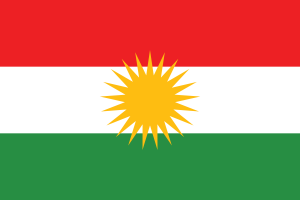Language/Northern-kurdish/Grammar/Nouns
Hi Northern Kurdish learners! 😊
In this lesson, we will deepen our knowledge of Northern Kurdish grammar by focusing on nouns. Nouns are words that represent people, places, things, or ideas. Understanding how to use them correctly is essential to express yourself clearly and coherently.
With the completion of this lesson, consider investigating these related pages: Northern Kurdish Grammar: Subordinating Conjunctions, Northern Kurdish Grammar Lesson: Understanding Place Adverbs, Accusative Case & Adjectives.
Noun Gender[edit | edit source]
In the Northern Kurdish language, all nouns have a gender. They are either masculine or feminine. Unlike in English, gender in Kurdish applies to inanimate objects as well. Unfortunately, there are no rules to predict the gender of nouns, so you have to memorize them.
Here are a few examples:
| Northern Kurdish | Pronunciation | English |
|---|---|---|
| çêlek (masculine) | [tʃɛːˈlɛk] | Stone |
| zeviyên (feminine) | [zɛvˈjɛːn] | Mountains |
| mal (masculine) | [maːl] | House |
| kolan (feminine) | [koˈlan] | Streets |
You can notice that there is no pattern whatsoever to deduce the gender of a noun. Therefore, you just need to learn it by heart.
As a side note, in the Kurdish language, there is no neutral gender. Everything is either masculine or feminine.
Singular and Plural[edit | edit source]
Another important aspect of Northern Kurdish nouns is singular and plural forms. To indicate that there are more than one of something, you need to modify the noun's ending.
- Masculine Nouns
To make a masculine noun plural, you add the suffix "-an" to the end of the word.
- Example: bajar (city) → bajaran (cities)
- Feminine Nouns
To make a feminine noun plural, you usually add the suffix "-ên".
- Example: roj (sun) → rojan (suns)
However, some feminine nouns change their entire spelling to become plural.
- Example: kevir (wall) → kivir (walls)
And some others only add the suffix "-an".
- Example: mirov (person) → mirovan (people)
Be aware that there is no strict rule for feminine nouns' pluralization, so we recommend that you learn each case individually.
Possessive Nouns[edit | edit source]
A possessive noun indicates that someone owns or has something. In Northern Kurdish, the possessive pronouns are very similar to the English ones.
To form a possessive noun, you first add "-î" to the noun if it is masculine and "-ya" if it is feminine. Then, you attach the pronoun that indicates who owns the object.
- Masculine Nouns
| Northern Kurdish | Pronunciation | English |
|---|---|---|
| bira min | [biːˈra mɪn] | My father |
| pesnêr te | [pɛsˈnɛːr tɛ] | Your (singular) shirt |
- Feminine Nouns
| Northern Kurdish | Pronunciation | English |
|---|---|---|
| çavkaniya min | [tʃavkaːniˈja mɪn] | My eye color |
| pirtûka te | [pɪrˈtuːka tɛ] | Your (singular) book |
Be careful with the pronunciation of possessive pronouns. Their endings can change according to the first letter of the following word.
Dialogue[edit | edit source]
Here's a short dialogue that illustrates some of the concepts we learned in this lesson:
- Person 1: Salam! ⛰️ کۆی ئۆمەد وەرگی ئەو پاڵەیە. (Hi! We will climb that mountain.)
- Person 2: Beşdar bûyî? دەگەڕێنی؟ (Are you coming with me?)
- Person 1: Na, man beşdar nakim. Ez lotikxaneke nû kriyetim. (No, I'm not coming with you. I have to write a new novel.)
- Person 2: Herweha nivîskarî, çima wekî yek ji qelayên wêneyan nemînin? (Besides writing, why don't you come with us to take some pictures of the castles?)
- Person 1: Wey, ev yekî dîrokî ye, ez li hevçênan dixwazim bêtin hevdu, lê nezinim çi wate. (Sure, this is historical. I want us to be together, but I don't know how to say it.)
Translation:
- Person 1: Hi! We will climb that mountain. ⛰️
- Person 2: Are you coming with me?
- Person 1: No, I'm not coming with you. I have to write a new novel. 📚
- Person 2: Besides writing, why don't you come with us to take some pictures of the castles? 🏰
- Person 1: Sure, this is historical. I want us to be together, but I don't know how to say it.
Conclusion[edit | edit source]
Mastering Northern Kurdish nouns and their characteristics is vital for every language learner who wishes to speak and write correctly. You must pay attention to gender, singular, plural, and possessive forms, and practice their usage regularly. To improve your Northern Kurdish grammar, you can also use the Polyglot Club website. Find native speakers and ask them any questions! Don't forget that grammar is not a mere set of rules but a way to express your thoughts thoroughly and beautifully.
➡ If you have any questions, please ask them in the comments section below.
➡ Feel free to edit this wiki page if you think it can be improved. 😎
Sources[edit | edit source]
Impressive work on finishing this lesson! Explore these additional pages to enhance your understanding: Northern Kurdish Grammar: Learn about Personal Pronouns in ..., Verb Conjugation, 0 to A1 Course & Roots of Northern Kurdish.

